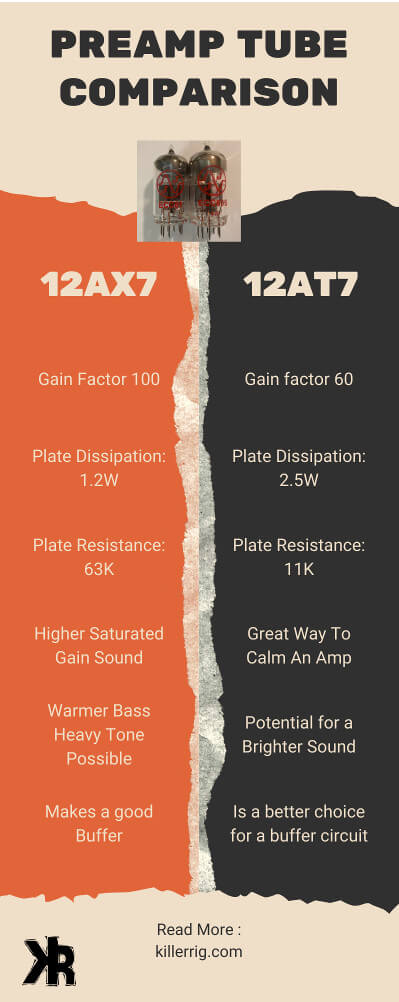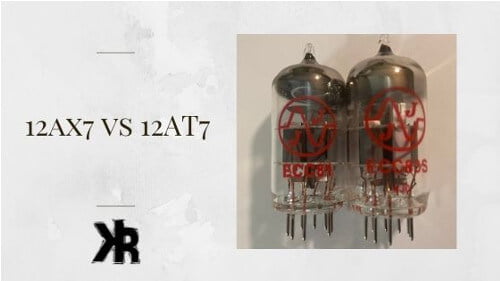Table of Contents
There is a lot of confusion between 12AX7 vs 12AT7 tubes, what they do and where they can be used. Most people hear that one has more headroom. They then jump right in, sometimes only to be disappointed by the result.
The main difference is the gain factor. The 12AX7 has a gain factor of 100 while the 12AT7 is 60. This alone means they can’t just be substituted in all applications.
Some people use the 12AT7 to get more headroom. But it comes at the expense of sound and performance in many cases.
In this Killer Rig article, we will look at differences and see what they are each better at for sound and performance.
Differences Between 12AX7 and 12AT7 Tubes
12AX7:
- Gain output of 100.
- Mostly used in the preamp section of guitar amplifiers to boost the signal.
- Clips and distorts much sooner due to its high gain.
- Provides more gain than the 12AT7.
- It can lead to a more distorted sounding tone. This is perfect for hard rock and metal music.
12AT7:
- Gain output of 60. This means it is just above half the output of a 12AX7.
- Also used in phase inversion and effects pedals.
- Provides more headroom than the 12AX7, giving a clearer, crisper, less distorted signal.
- Provides a sound with less distortion and more headroom than the 12AX7 when used as a phase inverter tube.
- Suitable for playing jazz guitar or when a clean signal is desired. Not great for heavier music.
These two tube types are very different in what they are capable of doing. Both electrically and sonically. The guitar sound you will get from either one will differ a lot because of their design.
The main differences between the 12AX7 and the 12AT7 are:
- Output gain factor.
- Plate dissipation rating.
- Resistance of the plates.
- Current Draw.
- Overall sound.
Let’s look at these differences in more detail and see how this would affect your guitar sound.
Output Gain Factor
The biggest difference between these two tubes is their output gain factor. The 12AX7 has a gain factor of 100. While the 12AT7 only has a gain factor of 60.
This means that the 12AX7 will amplify your signal 40% more than the 12AT7. This can be good or bad depending on what you are trying to achieve.
For example, if you are using a boost pedal to push your amp into overdrive, then you would want to use the 12AX7. This is because it will amplify the signal more. But it will also give you more distortion.
Are you trying to get a cleaner guitar sound with little distortion? Then the 12AT7 would be a better choice. This is because it will not amplify the signal as much. It would not drive the circuit into distortion comparatively.

Plate Dissipation Rating
The next difference between these two tubes is their plate dissipation rating. The 12AX7 has a plate dissipation rating of 1.2 watts. While the 12AT7 is rated at 2.5 watts.
This is important because it tells you how much power each tube can handle. The 12AX7 can only handle 1.2 watts of power before it would begin to fail. The 12AT7 on the other hand can handle two times as much at 2.5 watts.
These characteristics are more important to a designer than they would be to a musician. But they are worth mentioning.
Resistance of the Plates
The next difference is the resistance of the plates. The 12AX7 has a plate resistance of 63,000 ohms. While the 12AT7 has a plate resistance of 11,000.
This means it has a very direct impact on the sound they will produce when used in the same circuit. If you have ever installed a 12AT7 in place of a 12AX7, you probably noticed a slight loss of bass.
This is due to the different plate resistance ratings between the two tube types. The circuit is changed a great deal by the different resistance and will also respond as such.
Current Consumption
The two tubes have different resistance ratings for their plates. This means that the current draw will also be dissimilar. A 12AX7 will draw less current than a 12AT7.
As a result, the 12AT7 will also pull the supply voltage down a great deal more than a 12AX7 will. In some circuits, this might affect the whole amp and all the other stages. While this will not hurt your amp, it could change how it performs, good or bad.
This extra current draw makes the 12AT7 a great driver tube for effects loops or reverb stages.
Sound Differences
Now that we have looked at how radically different these two tubes are, the amp’s sound will be altered as well.
The 12AX7 will give you a hotter signal into any stages that are cascaded to its output. If you have an amplifier designed to use them, then swapping to a 12AT7 will be quite noticeable.
You will still notice the distortion. The amp will still sound the same. Except, you will have less gain on the same settings.
The two main differences will be less gain and bass content when a 12AX7 is changed out with a 12AT7. For anyone looking to soften and tame an amplifier, this might be a great way to do so. If not, a 12AX7 is an aggressive but warm tone.
Not every amplifier is made the same, and so for some guitarists, it might not work so well. Especially if you have a bright amplifier. But you will only know if you try.

More Headroom From a 12AT7?
There are a lot of people that say you will get more headroom from a 12AT7, but it isn’t what you think. Because a 12AT7 puts out 30% less gain, it is almost like simply turning your drive control down the same amount.
For some stages in an amplifier, this might work out well. While it does take more signal to distort a 12AT7, this tube also pulls down the high voltage. This means that the operating conditions are altered to a point where it is now easier to distort.
And so the extra headroom is sort of out the window when used in a circuit designed for a 12AX7.
The only thing that helps here is the fact that it puts out less gain and will seem to calm down the amplifier a bit.
But you must be careful where you put this tube. For example, if you change an FX loop tube in an amplifier designed to use a 12AX7. You will lose a considerable amount of volume.
Especially if you use 6L6 or EL34 tubes in the power section. The lack of drive to get them going will be noticeable. Yet, when changing a 12AX7 in the V1 spot in your amp, you will have a different effect.
If the circuit is designed properly for a 12AT7 tube, then yes, there is a substantial amount more headroom comparatively.
12AX7 vs 12AT7 As a Phase Inverter
Both types make great phase inverter tubes, but only if the circuit is optimal for them. A 12AT7 can drive a power section just as well as or better than a 12AX7. Especially when the circuit is designed around its electrical characteristics.
If you use a 12AT7 in a phase inverter circuit designed for a 12AX7, you will get less drive from your power section. This of course also depends on the power tubes being used, as some are easier to drive than others.
For example, a 6L6GC requires a decent signal to push them to very high volumes. Whereas a 6V6 doesn’t expect much and gets loud with a smaller signal. In this case, a 12AT7 will still drive them well even if the circuit was designed for a 12AX7.
Do you have a 6V6-driven tube amp that gets out of control too soon when you turn up the volume? A 12AT7 can be a great audio solution.
Which One Should You Choose?
The question of which triode is right for you really depends on what you are trying to achieve. If you want more gain and distortion, go with a 12AX7. If you want less gain and to tame an amplifier down some, go with a 12AT7.
The 12AT7 is also a better tube when used in an effects loop and anywhere that requires a buffer. Is your amp is designed to use a 12AX7 in these positions? Then stick to the manufacturer’s recommendations.
In the end, it is all about trying different things and experimenting with what sounds best to you in your amps.
FAQs
Can I use 12AT7 instead of 12AX7?
Yes, you can use a 12AT7 in place of a 12AX7 without having to worry about any problems. The changes these 2 tubes make in your amplifier will be well worth experimenting with. Especially as you search for your sound.
Do preamp tubes affect tone?
Yes, preamp tubes have a large effect on your tone. Especially when you interchange 12AX7 and 12AT7 triodes. This is one of the largest changes to your sound you can get with preamp tubes. And they are still cheap enough that this won’t cost a ton to try.

